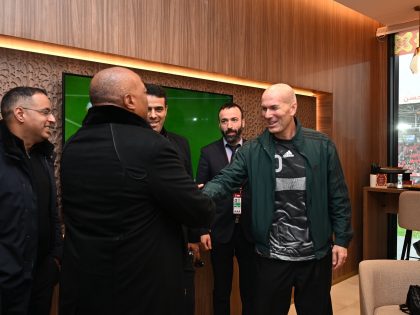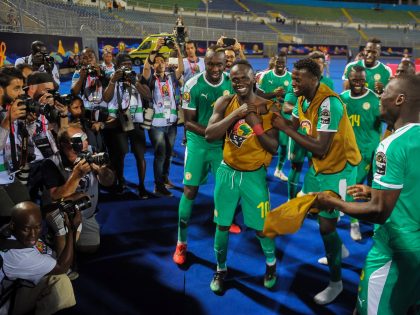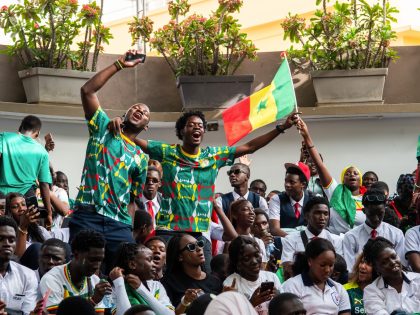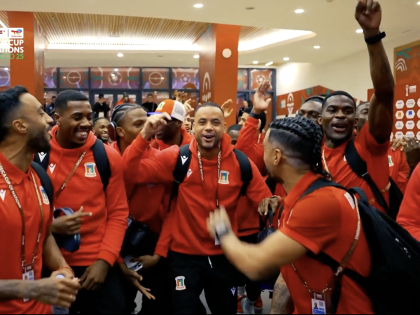The Art of Mimi Cherono Ng’ok
After years in South Africa, Ng'ok's work now explores her own relation to places, people and spaces of her native Nairobi.

Mimi Cherono Ng’ok (b. 1983) is a young Kenyan photographer who lives and works in Nairobi. Educated at the University of Cape Town in 2006, she has a number of exhibition and projects behind her; from studies in Cape Town, to residencies in Accra, Brazil and Berlin to exhibitions in Italy and Mozambique. However far, she has always been returning to Kenya, although coming home has not always been easy. After many years in South Africa returning to Nairobi left her with a feeling of displacement, but also gave her the unique opportunity of exploring places and spaces anew, which is reflected in some of her work.
In 2008 she produced a solo exhibition, “I am Home,” on African immigrants living in South Africa. “I am Home” is series of black and white portraits where Mimi addressed the sensitivity, subtlety and complexity of life in South Africa as an African, as the other other. The humanistic and sensible approach that characterizes this series is also prevalent in a more personal body of work, a series still untitled, exploring her own relation to places, people and spaces of her native Nairobi. As much of her work this series evolve around issues of home, displacement, loss, and identity. With a great deal of personal investment Mimi has created an intimate and deep body of work that is at once heart-warming, sad and beautiful. While some of the photos could be taken straight out of a family album, others seem to be merely stills from Mimi’s life in Nairobi. In sum they are all part of Mimi’s visual diary of an imaginary journey. We had a chance to ask Mimi a few questions about her untitled series, her work in general and about how traveling and coming home informs her photographic trajectory.
KO: When did you first become interested in photography?
MCN: Actually I first took pictures when I was about 4 years old, at the 1987 All Africa games that were held in Nairobi. I found the images recently; so far I have three very out of focus photographs of probably an opening event at Nyayo Stadium. So I’m not sure if there was some subconscious interest there but later on when I was around 12 my dad gave me a point and shoot – one of those plastic ones a lot of tourists used to have, they’re silver, no lens and have a really funny flash – and I would take pictures of random things around the house or my little sister when she took naps, my books on the shelf, the calendar. Really strange now when I look at some of the images…
Who or what has inspired you or influences your work?
Spike Lee’s movie ‘Crooklyn’ has been an influence in some of my work. As a child, I loved the movie when it first came out and now when I watch it again, there’s a lot of ‘stills’ in the movie that really resonate with what I’m doing now. A seminal work that I still keep coming back to all the time is Felix Gonzalez-Torres’ ‘Untitled’ 1991 billboard installation. The installation was 24 billboards of an enlarged black and white photograph of a recently shared double bed, in different parts of New York City. It was the first work that I encountered that was a return to experience, to memory. It was also the first time I had a visceral reaction to an art piece. When I read about it, it made complete sense what he was doing. It was really incredible that he made a work about love, loss, memory, sadness and intimacy, and that so many people related to it. You didn’t have to know the personal details to access what he was getting at. What’s weird though is when I show a lot of my friends the work, they don’t think much of it…but I think seeing Gonzalez-Torres working on such ideas impacted me getting to this point with my own work. I guess he was the map I needed.
What else…also Japanese photo books, I’m really drawn to how a lot of Japanese photographers constantly push photography in different directions. They have so many different approaches to technique, form, content and presentation. It always challenges me to think of my own work differently.
Looking at your work much of it seems to evolve around personal views and experiences. Is photography a way for you to process experiences?
I think yes, part of it is to process experiences, and at the same time it’s also a new way of seeing.

(Newspapers at Cugu’s house, 2012 © Mimi Cherono Ng’ok)
Your most recent work has a very private and intimate character. Can you explain a bit more about the background and focus of this series?
I started shooting some of the work in the series around 2008 when I first returned to Nairobi. At that time I wasn’t cognizant on working on a specific theme. I felt really displaced coming back to Kenya and wasn’t sure what to do with myself or what direction to go in. I was busy complaining to one of my friends about this, and as a result of a lot of the conversations we had, I ended up shooting whatever caught my attention. None of it made sense at the time, and I guess part of the frustration was that I couldn’t isolate exactly what I was working on as a subject. So I had these random pictures that I took throughout the year till I moved back to Cape Town. I didn’t think about them much until a couple of years later when I was scanning the images. Suddenly I could draw a lot of relationships between what I first thought were very disparate images and ideas. Also, I noticed that I had been taking a lot of images of my family as well as spaces around where I lived…and because I was so familiar with the people I was photographing and spending so much time with them there was an intimacy present that I hadn’t had with other projects. The work was definitely more personal, and I guess looking at it now part of it is an exploration of my relationship to Kenya, in past and present tense…as when I first left there was so many things I missed about the place, and when I came back, none of those things were present any more. So it functions like a visual diary; my visual diary that documents an imaginary sentimental journey I seem to be on.
Are you pursuing any particular style or aesthetic in this work?
Not at this point. I have an eclectic mix of images, some are black and white, others colour, some shot on medium format, others on 35mm film. The only constant so far is all the work is shot on film, which I won’t change any time soon. I really like that it’s a bit of mashup, especially since that’s how personal diaries are. Predominantly what I’m interested in is this space of memory and fiction, this middle line between veracity/recollection.
You studied in South Africa and came back to Kenya a few years ago. Have your years abroad made you look differently at your home country? And have they somehow informed your current work and life?
I think so. I guess distance always gives you perspective. I think the years away have made me feel almost like a stranger, or that actually what I found very familiar is not anymore, which in some ways is a good thing because that allows me to work and rediscover the country again. It’s a new way of seeing. Looking at places you’ve been to a million times but only start to really see for the first time once you create some distance.
I also think studying photography in South Africa has had a big impact on my work and life. It is a place that has a strong tradition of documentary photography which is what I started working with in the beginning. But more importantly it exposed me to a lot of different styles and genres present in photography, works by older photographers such as Santu Mofokeng, David Goldblatt, Ernest Cole, to younger photographers like Zanele Muholi, Nontsikelelo Veleko, Musa Nxumalo, Thabiso Sekgala who all have distinct ways of working. I think in Kenya photojournalism has been a very dominant factor to the detriment of other forms of photography. Also it was while I was in South Africa that I got a grant from the Market Photo Workshop to shoot a series and present a solo exhibition of the finished project.
You’ve been traveling quite a lot the last few years. How does traveling and residencies in other countries affect you and your work?
For me traveling brings about a lot of exposure, to new ideas, different kinds of people, new languages. I always come back to Nairobi looking at it differently. There’s a lot of cities I’ve been to and they feel really familiar, similar to Nairobi and some are completely different…I like that polarity of trying to make sense of the different symbols and codes you encounter in new places, and how they force you to reinvent your own sense of language about who you are and where you come from.
Last year you were part of the second Mwangalio Tofauti II exhibition, arranged by the Goethe Institute. This time the exhibition highlighted young upcoming photographers from Kenya. What is your experience as a young photographer in Kenya in terms of finding jobs, possibilities for exposure, general appreciation of photography etc.?
It’s challenging. I think there are certain kinds of photography that people really relate to here, predominantly wedding photography/photojournalism kind of work, and if you don’t make that kind of work, people are not really sure what to do with you… But the great thing about this is that the space is really open for experiments. I feel like I’m almost operating in a sort of vacuum, which allows me to do things I wouldn’t necessarily do if I were living in Cape Town or a different part of the world. When I had a solo show at the Goethe Institut, I knew my work would be completely new terrain to the audience, so I opted to use that opportunity to create a show about process and put up new video work that I was trying out. So I’m happy to have that kind of latitude…

(Old bed, 2013 © Mimi Cherono Ng’ok)
What do you think it takes for photography to grow as an industry and art in Kenya?
I think it’s growing as an industry, as an art it just needs to expand to become a bit more diverse, and this will only happen with exposure and awareness of the different kinds of work being made around the world and increased education. I hope the arts can really be brought back into the Kenyan curriculum. I was always bored in school and this was the one class I actually enjoyed.
Finally, can you point at other photographers from the Continent you find interesting?
In Kenya, I really like Amirah Tajdin and James Muriuki’s work. Amirah and I have similar sensibilities, and James works in a completely opposite way than I would, and takes images of things I would never really consider. I participated in a workshop initiated by Simon Njami that had a cross section of photographers from the continent. Through the workshop I was introduced to other young photographers on the continent, and now I’m really blown away by all the different work that’s out there. There’s Fatoumata Diabate and Patrick Wokmeni who have been making images on nightlife in their countries, completely different in its visual narrative. Someone else I like is George Senga who did this series on a man who reordered his life to be exactly like Patrice Lumumba after Lumumba was assassinated. It’s an incredible body of work. There are so many interesting young photographers out there and I hope somehow this can intersect into Nairobi’s visual landscape. For me I find that the possibilities within photography are endless, and at this point I’m just scratching the surface.
- This interview was first published on Addis Rumble.



















